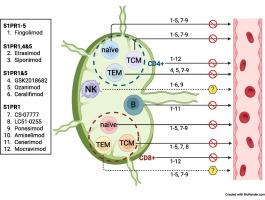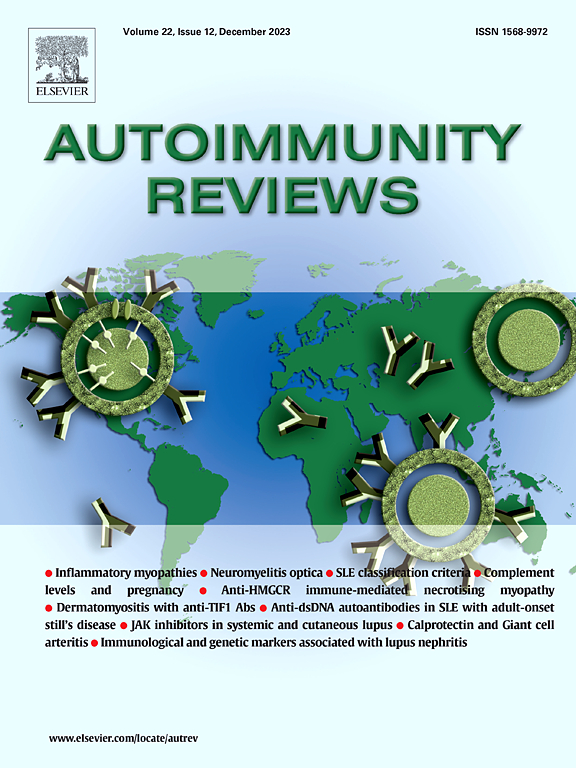鞘氨醇-1-磷酸受体调节剂治疗对不同临床适应症白细胞亚群的影响:一项系统综述。
IF 8.3
1区 医学
Q1 IMMUNOLOGY
引用次数: 0
摘要
背景:鞘氨醇-1-磷酸受体(S1PR)调节剂已被批准用于治疗多种自身免疫性疾病。虽然它们对总白细胞群的作用已被充分研究,但它们对特定白细胞亚群的影响仍不清楚。这篇系统综述描述了各种S1PR调节剂对人类白细胞亚群的影响。方法:通过PubMed、Medline、Embase和Cochrane数据库进行系统的文献检索,检索时间截止到2024年7月25日。如果研究涉及接受S1PR调节剂治疗的患者并提供白细胞亚群数据,则纳入研究。排除标准包括非英文文章、动物研究和体外研究。数据提取的重点是治疗后白细胞亚群的变化。结果:1658篇文献中,63篇符合纳入标准。芬戈莫德是最常被研究的药物,并显示出总t细胞计数的显著减少。更具体地说,CD4+ t细胞,包括naïve和中枢记忆群减少。CD8+ t细胞也减少,尽管效应记忆亚群的改变不一致。b淋巴细胞普遍减弱。先天免疫细胞表现出不同的反应,大多数研究表明减少或没有变化。其他S1PR调制器的数据也显示了类似的趋势。结论:S1PR调节剂主要减少T细胞和b细胞亚群,这两种细胞在免疫介导的炎症疾病中起着重要作用。需要进一步的研究来充分阐明针对S1PR特定亚型的药物之间的差异效应,重点是淋巴结或炎症组织部位(如肠粘膜和脑脊液),以探索这些药效学发现的确切临床意义。本文章由计算机程序翻译,如有差异,请以英文原文为准。

The effect of Sphingosine-1-phosphate receptor modulator treatment on leukocyte subsets across different clinical indications: A systematic review
Background
Sphingosine-1-phosphate receptor (S1PR) modulators are approved as a treatment for several autoimmune diseases. While their role on total leukocyte populations is well-studied, their effects on specific leukocyte subsets remain unclear. This systematic review describes the impact of various S1PR modulators on human leukocyte subpopulations.
Methods
We conducted a systematic literature search through the databases PubMed, Medline, Embase, and Cochrane, up to the 25th of July 2024. Studies were included if they involved patients treated with S1PR modulators and provided data on leukocyte subsets. Among the exclusion criteria, were non-English articles, animal studies, and in vitro studies. Data extraction focused on changes in leukocyte subsets post-treatment.
Results
Out of 1658 articles identified, 63 met the inclusion criteria. Fingolimod was the most frequently studied agent and displayed significant reductions in total T-cell counts. More specifically, CD4+ T-cells, including naïve and central memory populations were reduced. CD8+ T-cells also decreased, although the alterations of effector memory subsets were inconsistent. B-lymphocytes were generally attenuated. Innate immune cells showed variable responses, with most studies indicating a reduction or no change. Data on other S1PR modulators suggested similar trends.
Conclusion
S1PR modulators primarily reduce T- and B-cell subpopulations, which are known to play a prominent role in immune-mediated inflammatory disorders. Further research is needed to fully elucidate the differential effects among drugs targeting specific isoforms of the S1PR, focusing on the lymph nodes or inflammatory tissue sites (e.g. intestinal mucosa and cerebrospinal fluid), to explore the exact clinical implications of these pharmacodynamic findings.
求助全文
通过发布文献求助,成功后即可免费获取论文全文。
去求助
来源期刊

Autoimmunity reviews
医学-免疫学
CiteScore
24.70
自引率
4.40%
发文量
164
审稿时长
21 days
期刊介绍:
Autoimmunity Reviews is a publication that features up-to-date, structured reviews on various topics in the field of autoimmunity. These reviews are written by renowned experts and include demonstrative illustrations and tables. Each article will have a clear "take-home" message for readers.
The selection of articles is primarily done by the Editors-in-Chief, based on recommendations from the international Editorial Board. The topics covered in the articles span all areas of autoimmunology, aiming to bridge the gap between basic and clinical sciences.
In terms of content, the contributions in basic sciences delve into the pathophysiology and mechanisms of autoimmune disorders, as well as genomics and proteomics. On the other hand, clinical contributions focus on diseases related to autoimmunity, novel therapies, and clinical associations.
Autoimmunity Reviews is internationally recognized, and its articles are indexed and abstracted in prestigious databases such as PubMed/Medline, Science Citation Index Expanded, Biosciences Information Services, and Chemical Abstracts.
 求助内容:
求助内容: 应助结果提醒方式:
应助结果提醒方式:


